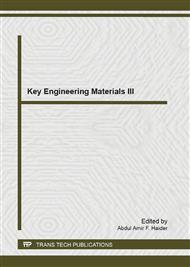p.71
p.77
p.82
p.87
p.93
p.98
p.103
p.108
p.115
Effect of Chitosan Compounds on Composite Fibers Properties
Abstract:
The primary aim of this paper is to provide an insight on the effect of chitosan compounds on the properties of polypropylene/chitosan composite fiber prepared by melt spun process. Three types of chitosan powder including ball mill prepared chitosan, spray dry prepared chitosan, and soybean oil-g-chitosan were employed for the preparation of chitosan compounds using polypropylene as polymer matrix. Then, chitosan compounds were incorporated into polypropylene fibers by melt spinning process. Polypropylene fibers containing chitosan particle loadings of 0.5 wt%, 1 wt%, and 3 wt% were prepared. Tensile strength, thermal property, morphology of chitosan compounds and fibers were investigated. The soybean oil-g-chitosan particles were found well distributed in PP matrix due to the compatibility of hydrophobic interfaces. However, spray dry-chitosan exhibited the best reinforcement effect by imparting the highest toughness compared to the others.
Info:
Periodical:
Pages:
93-97
Citation:
Online since:
May 2013
Authors:
Keywords:
Price:
Сopyright:
© 2013 Trans Tech Publications Ltd. All Rights Reserved
Share:
Citation:


